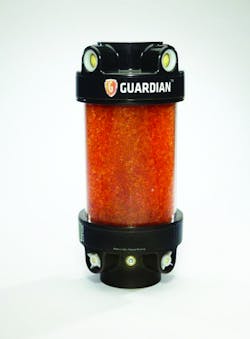Desiccant breather incorporates check valves for longer life
As designers have learned more about the detriments of hydraulic fluid contamination, they’ve been incorporating techniques to keep dirt and moisture out of hydraulic systems. Reservoirs have been one of the most common points of entry for dirt and moisture. Fortunately, filter breathers that incorporate moisture-adsorbing desiccant provide a simple and inexpensive way to keep dirt and water out of reservoirs.
A typical desiccant type breather contains particulate filters and a bed of desiccant. As fluid level in the reservoir drops, air is drawn in through the filter breather, where it passes through a 2-µm filter. Air then passes through the desiccant to remove moisture, then passes through a final 2-µm filter before entering the reservoir. This triple layer of filtration provides clean dry air to the head space in hydraulic reservoir. When fluid level rises, air within the reservoir is expelled back out through the breather.
Air Sentry, Rockwall, Texas, improves on this process with its Guardian line of desiccant filter breathers. According to Steve Anderson, of Air Sentry, Guardian draws incoming air through the filters and desiccant, but all exhaust air is expelled directly out to atmosphere. Anderson says, “This extends the life of the desiccant as much as 60% to 70% because the desiccant is not depleted by adsorbing moisture from exhaust air.”
Check and double check
The Guardian has two check valves — one for the inlet and one for the outlet. When no air movement occurs, the check valves prevent ambient air from coming into contact with the desiccant, thus extending breather life.
The Guardian is also designed to be more durable than standard breathers. Its 1- or 2-in. NPT port is made of aluminum and molded directly into the unit’s bottom cap. This makes the aluminum insert an integral part of the bottom cap, providing a much stronger base than an injection-molded port. It also allows use of thread sealant for a strong and water tight seal between the reservoir and breather. The housing itself is molded from Tritan copolyester, which offers higher impact strength and temperature and chemical resistance than plastics commonly used in desiccant filter breathers.
An optional stack ring allows multiple cartridges to be stacked atop each other for longer breather life and higher moisture removal capabilities. It also means less servicing and maintenance costs. Stacking vertically puts more breathers in series with one another; they can also be placed on a horizontal manifold to allow for more breathers in parallel and doesn’t reduce air flow.
A single Guardian breather accommodates 25 cfm of inlet air to the reservoir and more than 150 cfm of exhaust air flow, as which is routed directly to atmosphere instead of back through the breather.
Finally, Anderson points out the importance of keeping hydraulic oil from contacting the desiccant. “If the desiccant becomes coated with oil, it will no longer adsorb moisture. To prevent the misting or splashing from reaching the desiccant with standard desiccant breathers, the breather must either be remote mounted or a stand pipe must be incorporated to extend the breather away from the reservoir. The Guardian can be ordered with an isolation check valve to prevent fumes, vapors and misting from backing up into the breather.”
For more information, call Air Sentry at (972) 771-1000 or click here.


